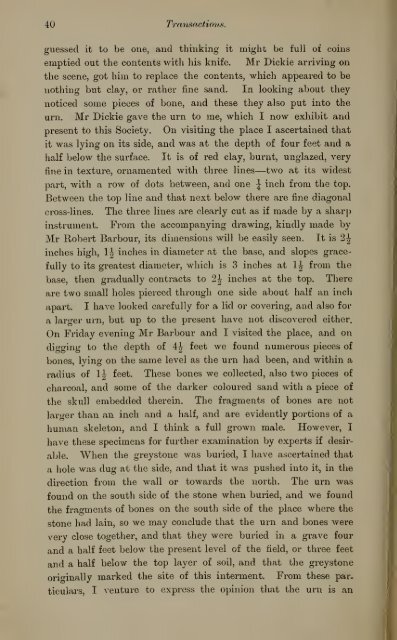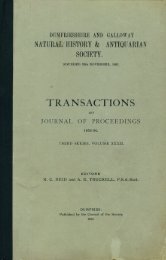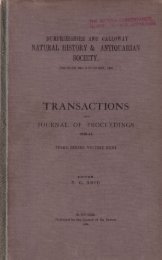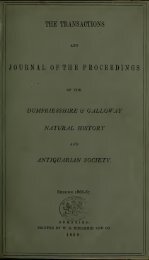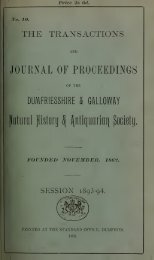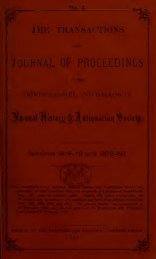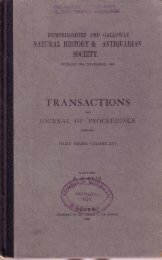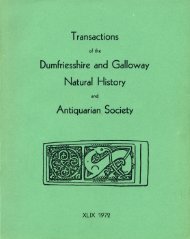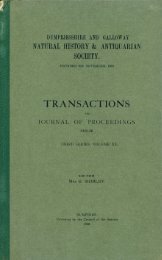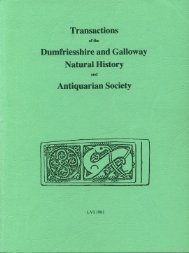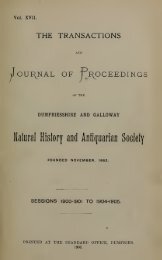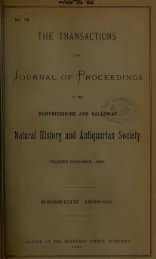Vol 5 - Dumfriesshire & Galloway Natural History and Antiquarian ...
Vol 5 - Dumfriesshire & Galloway Natural History and Antiquarian ...
Vol 5 - Dumfriesshire & Galloway Natural History and Antiquarian ...
You also want an ePaper? Increase the reach of your titles
YUMPU automatically turns print PDFs into web optimized ePapers that Google loves.
40 Transnctio7is.guessed it to be one, <strong>and</strong> tliinking it miglit be full of coinsemptied out the contents with his knife. Mr Dickie arriving onthe scene, got him to replace the contents, Avhicli appeared to benothing but clay, or rather fine s<strong>and</strong>. In looking about theynoticed some pieces of bone, <strong>and</strong> these they also put into theurn. Mr Dickie gave the urn to me, which I now exhibit <strong>and</strong>present to this Society. On visiting the place I ascertained thatit was lying on its side, <strong>and</strong> was at the depth of four feet <strong>and</strong> ahalf below the surface. It is of red clay, burnt, unglazed, veryfine in texture, ornamented with three lines—two at its widestpart, with a row of dots between, <strong>and</strong> one J inch from the top.Between the top line <strong>and</strong> that next below there are fine diagonalcross-lines. The three lines are clearly cut as if made by a sharpinstrument. From the accompanying drawing, kindly made byMr Robert Barbour, its dimensions will be easily seen. It is 2^inches high, 1^ inches in diameter at the base, <strong>and</strong> slopes gracefullyto its greatest diameter, which is 3 inches at 1^ from thebase, then gradually contracts to 2^ inches at the top. Thereare two small holes pierced through one side about half an inchapart.I have looked carefully for a lid or covering, <strong>and</strong> also fora larger urn, but up to the present have not discovered either.On Friday evening Mr Barbour <strong>and</strong> I visited the place, <strong>and</strong> ondigging to the depth of 4^- feet we found numerous pieces ofbones, lying on the same level as the urn had been, <strong>and</strong> within aradius of IJfeet. These bones we collected, also two pieces ofcharcoal, <strong>and</strong> some of the darker coloured s<strong>and</strong> witli a piece ofthe skull embedded therein. The fragments of bones are notlarger than an inch <strong>and</strong> a half, <strong>and</strong> are evidently portions of ahuman skeleton, <strong>and</strong> I think a full grown male. However, Ihave these specimens for further examination by experts if desirable.When the greystone was buried, I have ascertained thata hole was dug at the side, <strong>and</strong> that it was pushed into it, in thedirection from the wall or towards the north. The urn wasfound on the south side of the stone when buried, <strong>and</strong> we foundthe fragments of bones on the south side of the place where thestone had lain, so we may conclude that the urn <strong>and</strong> bones werevery close together, <strong>and</strong> that they were buried in a grave four<strong>and</strong> a half feet below the present level of the field, or three feet<strong>and</strong> a half below the top layer of soil, <strong>and</strong> that the greystoneoriginally marked the site of this interment. From these particulars,I venture to express the opinion that the urn is an


